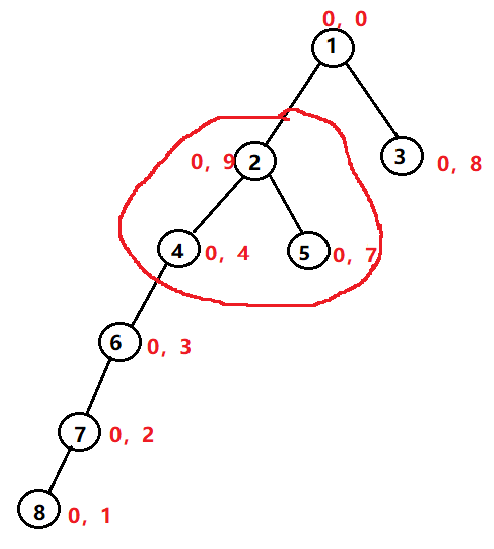题目链接:http://acm.hdu.edu.cn/showproblem.php?pid=1011
Starship Troopers
Time Limit: 10000/5000 MS (Java/Others) Memory Limit: 65536/32768 K (Java/Others)
Total Submission(s): 23806 Accepted Submission(s): 6342
To kill all the bugs is always easier than to capture their brains. A map is drawn for you, with all the rooms marked by the amount of bugs inside, and the possibility of containing a brain. The cavern's structure is like a tree in such a way that there is one unique path leading to each room from the entrance. To finish the battle as soon as possible, you do not want to wait for the troopers to clear a room before advancing to the next one, instead you have to leave some troopers at each room passed to fight all the bugs inside. The troopers never re-enter a room where they have visited before.
A starship trooper can fight against 20 bugs. Since you do not have enough troopers, you can only take some of the rooms and let the nerve gas do the rest of the job. At the mean time, you should maximize the possibility of capturing a brain. To simplify the problem, just maximize the sum of all the possibilities of containing brains for the taken rooms. Making such a plan is a difficult job. You need the help of a computer.
The last test case is followed by two -1's.
有n个洞穴编号为1~n,洞穴间有通道,形成了一个n-1条边的树, 洞穴的入口即根节点是1。
每个洞穴有x只虫子,并有价值y的金子,全部消灭完一个洞穴的虫子,就可以获得这个洞穴的y个金子.
现在要派m个战士去找金子,从入口进入。每次只有消灭完当前洞穴的所有虫子,才可以选择进入下一个洞穴。
一个战士可以消灭20只虫子,如果要杀死x只虫子,那么要x/20向上取整即(x+19)/20个战士。
如果要获得某个洞穴的金子,必须留下足够杀死所有虫子的战士数量, 即(x+19)/20个战士,然后这些留下战士就不能再去其它洞穴
其他战士可以继续走去其它洞穴,可以选择分组去不同的洞穴。
战士只能往洞穴深处走,不能走回头路
问最多能获得多少金子?
题意转自:https://blog.csdn.net/shuangde800/article/details/10069771
思路:典型的树形背包问题,这一题我用了两种方法写
特殊样例:
8 2 0 0 0 9 0 8 0 4 0 7 0 3 0 2 0 1 1 2 1 3 2 4 2 5 4 6 6 7 7 8
27
1.这种方法是我在一开始的代码一直wa然后看别人的思路改的,其中dp[i][j]表示以i节点构成的子树在有j个士兵的情况下最多可以获得的金钱数
代码:
#include<cstdio> #include<cstring> #include<algorithm> using namespace std; int val[110];//价值 int wet[110];//花费 bool vt[110];//标记数组 struct{//链式前向星 int v,next; }edge[220]; int cnt; int head[110]; void add(int u,int v){//加边 edge[cnt].v=v; edge[cnt].next=head[u]; head[u]=cnt++; } int dp[110][110];//dp[i][j]表示在以i个节点为根节点构成的子树中用j个士兵可以获得的最大金钱数 int n,m; void dfs(int k){ vt[k]=true; bool lg=true; if(wet[k]==0){//如果k是叶子节点并且它的花费为0,那么它的花费就要加一(因为你至少要派一个士兵去到这个房间才能获得该房间的金钱) for(int i=head[k];i!=-1;i=edge[i].next){ if(!vt[edge[i].v]) lg=false; } if(lg) wet[k]++; } for(int i=0;i<wet[k];i++)//初始化,要到达当前房间,需要的士兵数至少是wet[k],当士兵数小于wet[k]时可以获得的金钱数就为0 dp[k][i]=0; for(int i=wet[k];i<=m;i++){//当士兵数不少于当前房间的花费时,它可以获得当前房间的金钱 dp[k][i]=val[k]; } for(int i=head[k];i!=-1;i=edge[i].next){//看看是否可以往它下面的房间走使得得到的金钱数更多 if(!vt[edge[i].v]){ dfs(edge[i].v);//递归子节点 for(int j=m;j>=wet[k];j--){//尝试用子节点更新父节点 for(int l=wet[k];l<j;l++){ dp[k][j]=max(dp[k][j],dp[k][l]+dp[edge[i].v][j-l]);/*其中dp[k][]中保留着用上一个子节点更新父节点后的值, 相当于多重背包的上一样物品更新完后的背包,而当前子节点的值(dp[edge[i].v][])相当于当前物品*/ } } } } } int main(){ while(scanf("%d%d",&n,&m)!=EOF&&(n!=-1||m!=-1)){ fill(head,head+101,-1);//初始化 fill(vt,vt+101,false); for(int i=1;i<=n;i++){ scanf("%d%d",&wet[i],&val[i]); wet[i]=wet[i]/20+(wet[i]%20!=0);//转换一下花费,如果不足20个虫子也要派一个士兵 } int u,v; cnt=0; for(int i=1;i<n;i++){//边是双向的 scanf("%d%d",&u,&v); add(u,v); add(v,u); } dfs(1); if(m==0)//特判一下,当你没有士兵时无论如何都得不到金钱 printf("0 "); else printf("%d ",dp[1][m]); } return 0; }
2.这种方法是我最开始想到的,但是不知道为什么一直wa,然后找了半天才发现是自己没有充分理解 “如果当前节点花费为0且为叶子节点,那么它的花费要加一”这句话,我只考虑了完整的树的叶子节点花费为0的情况,而没有考虑到当我选出这棵树的部分的时候它叶子节点花费为0的情况.
在这种方法中,我的dp[i][j]表示的是以第i个节点为根节点时,向它的所有子树(不包括根节点)派遣j个士兵最多可以获得的金钱树
代码
#include<cstdio> #include<cstring> #include<algorithm> using namespace std; int val[110]; int wet[110]; bool vt[110]; struct{//链式前向星 int v,next; }edge[220]; int cnt; int head[110]; void add(int u,int v){ edge[cnt].v=v; edge[cnt].next=head[u]; head[u]=cnt++; } int dp[110][110];//dp[i][j]表示向以i为根节点(不包括i)的所有子树中派遣j名士兵最多可以获得的金钱数 int n,m; void dfs(int k){ for(int i=0;i<=m;i++){//初始化全部为0 dp[k][i]=0; } vt[k]=true; for(int i=head[k];i!=-1;i=edge[i].next){ if(!vt[edge[i].v]){ dfs(edge[i].v); for(int j=m;j>=wet[edge[i].v]&&j>=1;j--){ for(int l=0;l<=j-wet[edge[i].v];l++){ //printf("QQQ%d %d",dp[k][j-l-wet[edge[i].v]-(l==0&&wet[edge[i].v]==0)],dp[edge[i].v][l]); dp[k][j]=max(dp[k][j],dp[k][j-l-wet[edge[i].v]-(l==0&&wet[edge[i].v]==0)]+dp[edge[i].v][l]+val[edge[i].v]); //你当前选择用子节点更新它的父节点时,就算当前子节点的花费为0你也至少要派一个士兵 //(l==0&&wet[edge[i].v]==0)的作用就是判断是否有叶节点的wet为0 ,l==0代表现在是用叶节点来更新 //printf("QQQ%d %d %d %d %d %d ",k,edge[i].v,j,l,j-l-wet[edge[i].v]-(l==0&&wet[edge[i].v]==0),dp[k][j]); } //printf("qqqq%d %d %d ",k,j,dp[k][j]); } } } } int main(){ while(scanf("%d%d",&n,&m)!=EOF&&(n!=-1||m!=-1)){ fill(head,head+101,-1);//初始化 fill(vt,vt+101,false); for(int i=1;i<=n;i++){ scanf("%d%d",&wet[i],&val[i]); wet[i]=wet[i]/20+(wet[i]%20!=0);//简化花费 } int u,v; cnt=0; for(int i=1;i<n;i++){//边是双向的 scanf("%d%d",&u,&v); add(u,v); add(v,u); } dfs(1); if(m==0)//特判 printf("0 "); else{ if(m>=wet[1])//如果当前的士兵数大于根节点的花费数 dp[1][m-wet[1]]+=val[1]; printf("%d ",dp[1][m-wet[1]]);//如果小于的话不要else也是输出0 } } return 0; } /*
8 2 0 0 0 9 0 8 0 4 0 7 0 3 0 2 0 1 1 2 1 3 2 4 2 5 4 6 6 7 7 8
27
*/
当前我已经用节点5更新完了节点2,现在我用节点4来更新节点2,当更新dp[2][1]时,由于我dp的特殊性,当用dp[4][0]来更新dp[2][1]时,如果不注意上面的情况,就会发生
dp[2][1]=max(dp[2][1],dp[2][1]+dp[4][0]+val[4]),为什么呢,因为当前4节点的花费为零,如果我想只加上4节点时(即用dp[4][0]来更新时),会出现由于4节点花费为0而可以不用派士兵就可以得到它节点上的金钱的情况,而这种情况是不合法的,因为你至少要派一名士兵去4节点拿钱,而它不能走回头路,只能往下走。
